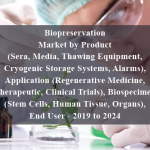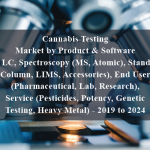OVERVIEW
The Mice Model Market is currently valued at USD 1.5 billion in 2024 and will be growing at a CAGR of 8.1% over the forecast period to reach an estimated USD 2.2 billion in revenue in 2029. The mice model market serves as a cornerstone in biomedical research, providing invaluable tools for understanding human physiology, disease mechanisms, and therapeutic development. These models, typically genetically modified or selectively bred for specific traits or diseases, mimic human conditions with remarkable accuracy, offering researchers a platform to study complex biological processes in a controlled environment. From investigating cancer and neurological disorders to testing potential drugs and therapies, mice models play a pivotal role in advancing medical knowledge and translating scientific discoveries into clinical applications. With advancements in gene editing technologies like CRISPR-Cas9 and the growing demand for personalized medicine, the global mice model market continues to expand, fueled by both academic research institutions and pharmaceutical companies seeking innovative solutions to pressing healthcare challenges.
The increasing prevalence of chronic diseases such as cancer, diabetes, and cardiovascular disorders underscores the need for effective preclinical research tools, driving demand for genetically engineered mouse models tailored to mimic these conditions. Additionally, advancements in genetic engineering technologies, particularly CRISPR-Cas9, have revolutionized the creation of precise and sophisticated mouse models, enabling researchers to model human diseases more accurately. Moreover, the rising adoption of personalized medicine approaches necessitates the development of patient-specific mouse models for drug testing and treatment optimization. Furthermore, collaborations between academic research institutions, pharmaceutical companies, and contract research organizations (CROs) are driving innovation and expanding the application of mouse models across various therapeutic areas.
Market Dynamics
Drivers:
The increasing prevalence of chronic diseases such as cancer, diabetes, and cardiovascular disorders underscores the need for effective preclinical research tools, driving demand for genetically engineered mouse models tailored to mimic these conditions. Additionally, advancements in genetic engineering technologies, particularly CRISPR-Cas9, have revolutionized the creation of precise and sophisticated mouse models, enabling researchers to model human diseases more accurately. Moreover, the rising adoption of personalized medicine approaches necessitates the development of patient-specific mouse models for drug testing and treatment optimization. Furthermore, collaborations between academic research institutions, pharmaceutical companies, and contract research organizations (CROs) are driving innovation and expanding the application of mouse models across various therapeutic areas.
Key Offerings:
In the mice model market, key offerings encompass a diverse array of products and services tailored to meet the evolving needs of researchers and pharmaceutical companies. These offerings include genetically modified mouse models engineered to mimic specific human diseases or traits, providing invaluable tools for studying disease mechanisms and evaluating potential therapies. Additionally, suppliers provide a wide range of wild-type mouse strains, offering researchers baseline models for various biomedical studies. Alongside mice models, suppliers offer comprehensive services such as breeding, genotyping, and phenotyping, streamlining the research process and allowing researchers to focus on their scientific objectives. Furthermore, suppliers often provide consultation services to assist researchers in selecting the most appropriate models and experimental approaches for their studies
Restraints:
Even with the encouraging growth prospects, there are a number of obstacles that the mouse model market must overcome to continue growing. The ethical issues surrounding the use of animals in research—including mice—remain difficult to resolve, which has increased public and governmental scrutiny. Adherence to strict standards on animal welfare is necessary, leading to elevated operational expenses and administrative strains for pharmaceutical businesses and research institutions. Furthermore, the intricacy and heterogeneity of human illnesses could restrict the translational significance of mice models, hence impeding their ability to precisely forecast human reactions to medications and treatments. Furthermore, the long development and maintenance timetable for genetically modified mouse models may discourage some researchers and organisations from using these models due to the significant expenses involved. Moreover, the dominance of traditional mouse models in preclinical research is being challenged by new alternative technologies including computational modelling and in vitro models. Notwithstanding these limitations, opportunities exist to overcome these obstacles and spur additional innovation in the mouse model market thanks to continuing developments in genetic engineering technologies and growing industry-academia collaborations.
Regional Information:
• In North America, particularly the United States, the market thrives due to robust biomedical research funding, a well-established pharmaceutical industry, and a favorable regulatory landscape facilitating preclinical research.
• Europe also boasts a significant market share, with countries like the United Kingdom, Germany, and France leading the way in biomedical research and innovation.
• Asia-Pacific, led by countries such as China, Japan, and South Korea, is witnessing rapid growth attributed to increasing investments in life sciences research, expanding pharmaceutical markets, and a growing emphasis on translational medicine. In contrast, regions with less developed research infrastructure and stringent regulatory frameworks may experience slower market growth.
Recent Developments:
• In December 2023, Biocytogen entered into a licensing agreement with Nuerocrine Biosciences. This agreement grants Neurocrine Biosciences the right to license selected antibodies for therapeutic product development, manufacturing, and commercialization for all uses worldwide.
• In July 2022, GemPharmatech has entered into a strategic licensing agreement with Charles River Laboratories to distribute its next-generation NOD CRISPR Prkdc Il2r gamma (NCG) mouse lines in North America.
Key Market Players:
Charles River Laboratories International, Inc., The Jackson Laboratory, Taconic Biosciences, Inc., Envigo, JANVIER LABS, genOway S.A., Horizon Discovery Group plc, Crown Bioscience, Inc., Trans Genic Inc., and Ingenious Targeting Laboratory, Inc.
Frequently Asked Questions
1) What is the projected market value of the Mice Model Market?
– The Mice Model Market is expected to reach an estimated value of USD 2.2 billion in revenue by 2029.
2) What is the estimated CAGR of the Mice Model Market over the 2024 to 2029 forecast period?
– The CAGR is estimated to be 8.1% for the Mice Model Market over the 2024 to 2029.
3) Who are the key players in the Mice Model Market?
– Charles River Laboratories International, Inc., The Jackson Laboratory, Taconic Biosciences, Inc., Envigo, JANVIER LABS, genOway S.A., Horizon Discovery Group plc, Crown Bioscience, Inc., Trans Genic Inc., and Ingenious Targeting Laboratory, Inc.
4) What are the drivers for the Mice Model Market?
– Chronic diseases like cancer, diabetes, and cardiovascular disorders demand genetically engineered mouse models for preclinical research. Advancements in genetic engineering technologies, like CRISPR-Cas9, enable accurate modeling. Personalized medicine and collaborations between academics, pharmaceutical companies, and CROs drive innovation and expand mouse models’ application.
5) What are the restraints and challenges in the Mice Model Market?
– The mice model market faces challenges due to ethical concerns, increased regulatory scrutiny, and the complexity of human diseases. High costs and long development timelines for genetically modified models may deter some researchers. Emerging technologies like in vitro models and computational modeling challenge traditional models in preclinical research. However, advancements in genetic engineering and collaborations between academia and industry can drive innovation in the mice model market.
6) What are the key applications and offerings of the Mice Model Market?
– The mice model market offers a range of products and services, including genetically modified mouse models, wild-type mouse strains, breeding, genotyping, and phenotyping services, and consultation services to help researchers select the most appropriate models and experimental approaches for their studies.
7) Which region is expected to drive the market for the forecast period?
– North America is expected to have the highest market growth from 2024 to 2029
Why Choose Us?
Insights into Market Trends: Global Market Studies reports provide valuable insights into market trends, including market size, segmentation, growth drivers, and market dynamics. This information helps clients make strategic decisions, such as product development, market positioning, and marketing strategies.
Competitor Analysis: Our reports provide detailed information about competitors, including their market share, product offerings, pricing, and competitive strategies. This data can be used to inform competitive strategies and to identify opportunities for growth and expansion.
Industry Forecasts: Our reports provide industry forecasts, which will inform your business strategies, such as investment decisions, production planning, and workforce planning. These forecasts can help you to prepare for future trends and to take advantage of growth opportunities.
Access to Industry Experts: Our solutions include contributions from industry experts, including analysts, consultants, and subject matter experts. This access to expert insights can be valuable for you to understand the market.
Time and Cost Savings: Our team at Global Market Studies can save you time and reduce the cost of conducting market research by providing comprehensive and up-to-date information in a single report, avoiding the need for additional market research efforts.












